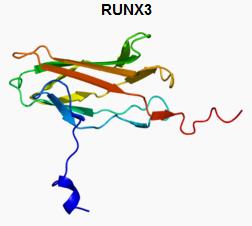Modifications to Protein RUNX3 May Promote Cancer Growth
New study also identified a potential way to increase effectiveness of cancer therapy.

Scientists from the Cancer Science Institute of Singapore (CSI Singapore) at the National University of Singapore (NUS) have discovered that modifications to a protein called RUNX3 may promote cancer progression. The results of the study were published recently.
The research team, led by Professor Yoshiaki Ito, Senior Principal Investigator at CSI Singapore, found that a modification called phosphorylation made to RUNX3 promotes cancer progression by allowing cell division. Uncontrolled cell division in the body is a process by which tumors form and hence is a hallmark of cancer. RUNX3 is a tumor suppressor gene that prevents the formation of tumors by binding to DNA.
The phosphorylation, or the addition of a phosphate group to a molecule, is carried out by an enzyme called Aurora Kinase, which has been observed to be present in unusually high levels in some cancers. Phosphorylation prevents the binding of RUNX3 to DNA, resulting in RUNX3 relocating to centrosomes, intracellular organelles that control the start of cell division.
"This study identifies a new post-translational modification to RUNX3, which provides RUNX3 with a novel role in the regulation of cell division. Our results suggest that frequent overexpression of Aurora Kinase in cancer may reduce RUNX3 transcription activity, leading to cell division and formation of tumors. Understanding the molecular mechanisms underlying Aurora kinase-overexpressing tumors will help in the design of targeted and personalized cancer therapy," said Dr Linda Chuang, Senior Research Scientist at CSI Singapore, who is the first author of the study.
"Unlike other modifications which stem from changes to the RUNX3 DNA itself or how DNA is read, phosphorylation does not accompany any changes in the DNA and is hence undetectable at the genetic level. Given that modifications such as phosphorylation are likely to be impermanent and reversible, the clinical implications are far-ranging. Moving forward, the team is looking into ways to assess the feasibility of enhancing RUNX tumor suppression or inhibiting RUNX mitotic function to kill rapidly proliferating cancer cells," said Prof. Ito.
Illustration: Structure of the RUNX3 protein. Based on PyMOL rendering of PDB 1cmo. Wikipedia.
Read more...
National University of Singapore News Release (07/15/16)
Science Daily (07/15/16)
Abstract (Proceedings of the National Academy of Sciences; 2016, 113 (23): 6490.)
The research team, led by Professor Yoshiaki Ito, Senior Principal Investigator at CSI Singapore, found that a modification called phosphorylation made to RUNX3 promotes cancer progression by allowing cell division. Uncontrolled cell division in the body is a process by which tumors form and hence is a hallmark of cancer. RUNX3 is a tumor suppressor gene that prevents the formation of tumors by binding to DNA.
The phosphorylation, or the addition of a phosphate group to a molecule, is carried out by an enzyme called Aurora Kinase, which has been observed to be present in unusually high levels in some cancers. Phosphorylation prevents the binding of RUNX3 to DNA, resulting in RUNX3 relocating to centrosomes, intracellular organelles that control the start of cell division.
"This study identifies a new post-translational modification to RUNX3, which provides RUNX3 with a novel role in the regulation of cell division. Our results suggest that frequent overexpression of Aurora Kinase in cancer may reduce RUNX3 transcription activity, leading to cell division and formation of tumors. Understanding the molecular mechanisms underlying Aurora kinase-overexpressing tumors will help in the design of targeted and personalized cancer therapy," said Dr Linda Chuang, Senior Research Scientist at CSI Singapore, who is the first author of the study.
"Unlike other modifications which stem from changes to the RUNX3 DNA itself or how DNA is read, phosphorylation does not accompany any changes in the DNA and is hence undetectable at the genetic level. Given that modifications such as phosphorylation are likely to be impermanent and reversible, the clinical implications are far-ranging. Moving forward, the team is looking into ways to assess the feasibility of enhancing RUNX tumor suppression or inhibiting RUNX mitotic function to kill rapidly proliferating cancer cells," said Prof. Ito.
Illustration: Structure of the RUNX3 protein. Based on PyMOL rendering of PDB 1cmo. Wikipedia.
Read more...
National University of Singapore News Release (07/15/16)
Science Daily (07/15/16)
Abstract (Proceedings of the National Academy of Sciences; 2016, 113 (23): 6490.)
